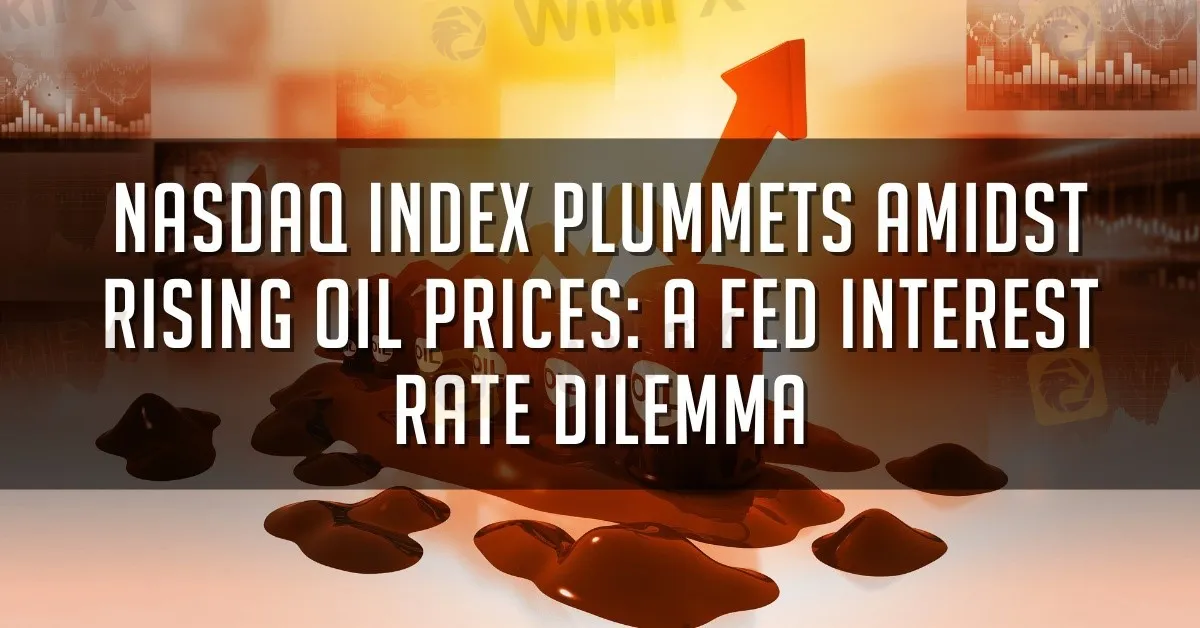Nasdaq Index Plummets Amidst Rising Oil Prices: A Fed Interest Rate Dilemma
Abstract:In an unstable market environment, the Nasdaq index experienced a severe devaluation, highlighting the correlation between the Federal Reserve's interest rate policies and escalating oil prices.

In an unstable market environment, the Nasdaq index experienced a severe devaluation, highlighting the correlation between the Federal Reserve's interest rate policies and escalating oil prices. There has been a noticeable change in the tone of ongoing conversations concerning the Federal Reserve's financial strategy. The emphasis is now more balanced, due to encouraging inflation figures and a steady job market.
Federal Reserve officials have displayed remarkable consistency and elevated interest rates in 11 of their last 12 meetings. In their most recent move in July, they pushed the range from 5.25% to 5.5%, marking a 22-year high. As the eagerly anticipated Fed meeting in September approaches, indications are that they may opt to maintain their current interest rates, affording them valuable time to assess the economy's response to the previous rate hikes.
The current debate revolves around the triggers that could prompt the Fed to consider raising rates again, potentially in November or December. In June, the consensus among most officials pointed to the necessity of a further quarter-point increase within the year. After the September meeting, projections might hint at another rate hike, but the ultimate decision remains uncertain.
However, the current focal point is the spiralling oil prices. The previous week saw oil prices surging to their peak levels for the year, with aspirations of breaching the coveted $100-per-barrel milestone before the year's end. Some analysts even postulate this milestone could be achieved sooner than expected.
Brent and WTI crude oil prices attained their highest points this year during the past week, marking a substantial ascent. Furthermore, these oil contracts have notched their third straight positive week amid ongoing concerns about supply constraints.
The recent rally in oil prices can be primarily attributed to strategic moves by Saudi Arabia and Russia aimed at depleting global oil inventories and extending their cuts in oil production until year-end. Saudi Arabia, the influential leader within OPEC, declared on September 5th its intention to continue its 1 million barrel per day production cut until the end of the year. Simultaneously, Russia, a crucial non-OPEC player, pledged to curtail oil exports by 300,000 barrels per day during the same period. Both nations have expressed their readiness to review these voluntary production cuts monthly.
It is imperative to recognise that oil prices wield substantial influence in determining inflationary pressures, given their impact on diverse sectors of the economy. As oil prices ascend, businesses across various industries contend with increased production and transportation expenses. This invariably translates to higher input costs, which may ultimately be passed on to consumers through elevated prices for goods and services. Furthermore, the surge in oil prices can reverberate through global supply chains, imposing cost pressures at various stages and potentially inflating prices for imported goods.
Considering these conditions, it's natural to wonder: Is there certainty that the Federal Reserve will conclusively end its ongoing rate increase cycle? A convergence of elements, such as the rise in oil prices, guarantees that the future of monetary policy is loaded with intricacies and unpredictabilities.

Read more

Broker Comparsion: FXTM vs AvaTrade
FXTM and AvaTrade are two well-established online brokers offering forex and CFD trading across global markets. Both enjoy strong reputations and high ratings on WikiFX—FXTM holds an AAA overall rating, while AvaTrade scores 9.49/10, indicating they’re regarded as reliable choices by the community. However, since brokers have great reputation in the industry, how do we know which one is more suitable for individuals to invest in? Today's article is about the comparison between FXTM and AvaTrade.

Shocking Move: Yen Breaks Past 140 Barrier!
The yen's breakout above the 140 mark has caught global attention, and the reasons behind it are more than technical.

FINRA fines SpeedRoute for alleged rule violations
The Financial Industry Regulatory Authority (FINRA) has imposed a $300,000 fine on SpeedRoute LLC for a series of supervisory, risk management, and anti-money laundering (AML) program deficiencies spanning from 2017 to the present. Of this amount, $75,000 is payable to FINRA, with the remainder offset by SpeedRoute’s limited ability to pay. In addition to the monetary penalty, SpeedRoute has been censured and ordered to overhaul its compliance framework, including enhancing its written supervisory procedures (WSPs) for market access controls and strengthening its AML program.

Nigeria's Oil Crisis: How Are Stakeholders Responding?
Despite being rich in oil, Nigeria struggles with refining shortages. What’s behind this paradox, and how are different actors reacting?
WikiFX Broker
Latest News
Love, Investment & Lies: Online Date Turned into a RM103,000 Scam
Broker’s Promise Turns to Loss – Funds Disappear, No Compensation!
Broker Took 10% of User's Profits – New Way to Swindle You? Beware!
Pi Network: Scam Allegations Spark Heated Debate
Broker Comparsion: FXTM vs AvaTrade
Account Deleted, Funds Gone: A New Broker Tactic to Beware Of?
El Salvador and U.S. Launch Cross-Border Crypto Regulatory Sandbox
The Instagram Promise That Stole RM33,000
Kraken Partners with Alpaca to Offer U.S. Stocks and Crypto
Before You Trade the Next Big Thing, Remember the Dot-Com Collapse
Rate Calc

